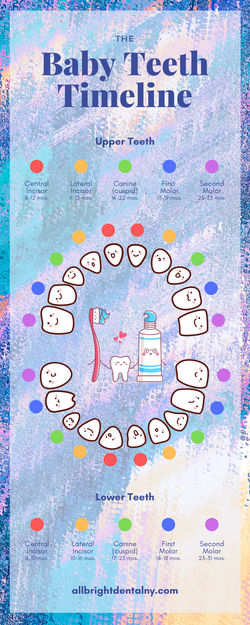
Every parent dreads their child’s teething phase—a period when an infant’s baby teeth begin to grow in between six months and a year old. While this discomfort is only temporary, a parent needs to understand the timeline for a child’s emerging smile as well as the importance of keeping it healthy as they grow. Here are a few common concerns that young parents ask dentists about their child’s baby teeth.
Baby Teeth vs. Permanent Teeth
Baby teeth, also known as milk, primary, or deciduous teeth, are already present in the jaw when a baby is born. They are noticeably smaller and whiter than permanent teeth. The whiter color, in particular, is because they have a thinner layer of enamel, which protects adult teeth but also makes them look yellower.
A child’s baby teeth have shorter, thinner roots, which allow them to fall out more easily when their adult teeth are ready to grow. They also lack mamelons—those bumps on incisors—that adult teeth have.
When Do Baby Teeth Come In?
 When a baby’s teeth emerge depends on the child, but typically, the earliest you’ll see your baby’s first tooth is around six months. The lower central incisors—the lower front teeth—are usually the first to grow in, followed by their upper equivalent and both sets of lateral incisors.
When a baby’s teeth emerge depends on the child, but typically, the earliest you’ll see your baby’s first tooth is around six months. The lower central incisors—the lower front teeth—are usually the first to grow in, followed by their upper equivalent and both sets of lateral incisors.
A baby’s first molar will be next, at around 13 to 19 months, and the canines pop in around 16 to 23 months. At the very back of the mouth, the second molars can take up to three years to arrive. In total, the average baby has 20 primary teeth in total.
Why Are They Important?
Communication
Baby teeth are essential to a child’s development in multiple capacities, including the ability to speak. When you think of a child that’s lost their first tooth, you imagine an adorable lisp in tow that they grow out of when their adult teeth emerge. Missing teeth can cause a speech impediment, which is why baby teeth are essential to a baby’s ability to communicate once they can understand language.
Nutrition
As a child’s baby teeth grow in, they can progress their diet to more substantial, nutrient-rich food. This step to solid foods is a vital component of a child’s growth and developmental needs during those toddler years. Without their baby teeth, their diet—and by extension, their development—would be severely stunted.
Dental Health
Besides helping a child to perform daily tasks like talking and chewing, baby teeth are also essential placeholders for adult teeth to come. By holding the space in a toddler’s gums, these primary teeth help to avoid permanent teeth from drifting out of place before they grow.
If a baby tooth is lost before the adult tooth is ready to come in, it can set off a chain reaction that results in a crowded or crooked smile. While dentists can fix this issue with orthodontia, taking care of your child’s baby teeth can set them up for a stronger smile for years to come.
How to Soothe a Teething Child
Massage Sore Gums
Sometimes a little TLC can help soothe your baby’s gums. After washing your hands thoroughly with soap and water, sit down with your baby and massage their sore gums in gentle circular motions. For a targeted approach, considering that they can’t communicate where the pain is, refer to the emergence timeline above for an educated guess of which tooth is growing into their smile.
Give Them Something Cold
 Like with other pain and discomfort, icing a baby’s sore gums can help. There are a couple of ways to approach this soothing method:
Like with other pain and discomfort, icing a baby’s sore gums can help. There are a couple of ways to approach this soothing method:
- Dampen a washcloth and throw it in the refrigerator. Once chilled, fold it up and hand it to your baby to chew.
- Cool a metal spoon in the fridge. When it’s cold, rub the back of the spoon against your baby’s irritated gums.
- Throw a solid teething toy in the fridge for added cooling when the baby chews on it.
- When your child can eat solid food, offer them chilled fruits in a mesh feeder, such as mashed banana, cooked apples, strawberries, mangoes, or pears.
For all four techniques, keep an eye on your child at all times in case of a choking hazard. For the teething toy, in particular, make sure that you avoid non-gel ones. The hollow gel types can be dangerous if a child ingested what is inside.
Give Them Acetaminophen
On some nights, your baby’s discomfort may extend beyond a simple gum massage or teething toy. When they’re stuck awake from teething pain, you can give them a minuscule dose of acetaminophen (more commonly known as the brand name Tylenol). This pain reliever can help a child that is clearly uncomfortable from teething, but you must discuss with your pediatrician or pediatric dentist the dosage for your baby’s age and weight. If they’re over six months, ibuprofen is also an option, but once again, the dosage is key. Regardless of the pain reliever you use, never use a numbing cream like belladonna or benzocaine on their gums, as the FDA advises against using them on infants.
Wipe Away Drool
When your baby’s teeth begin to grow in, you’ll notice that they drool a lot more. It’s essential to keep your baby’s face clean and dry to prevent a rash or skin irritation on their face, which only compounds their discomfort. To protect their face and their clothes, have them wear a soft bib to help you wipe away drool as it accumulates.
How to Care for Your Baby’s Smile
Incorporate Fluoride
By the time your child is six months old, your dentist will recommend that you incorporate fluoride into their day-to-day. This mineral helps prevent tooth decay by keeping a tooth’s enamel coating strong and healthy. Fluoride is commonly found in tap water, so start giving your child a few ounces of water every day when they begin eating solid food.
Brush Their Teeth
In addition to supplying your child with fluoride in water, you need to help them brush their teeth with fluoride toothpaste until they can do so on their own. For kids under three, use a baby toothbrush with a minuscule amount of toothpaste twice a day, preferably before their first meal of the day and after their last one. Never send them to bed with a bottle, even when they’re really little, as this habit can lead to tooth decay long term.
Once they turn 3, you can teach them to brush with a kid’s toothbrush and a pea-sized amount of toothpaste. You’ll need to monitor their brushing until they’re about age 6 or 7, typically when they’ve had a couple of baby teeth fall out.
Take Them to the Dentist
When your child’s first tooth appears, or they turn one—whichever comes first—make the first appointment with their dentist. Pediatric dentists are vital to a child’s long-term oral health, as they can monitor a smile’s development over those first few years and identify any potential issues. Dentists can also offer insight during the teething process as far as dosage for acetaminophen as well as other best practices for keeping your baby happy through the discomfort.
If your baby’s first tooth has arrived, a trusted dentist can ensure that their oral health starts on the right track. In Mamaroneck, NY, families turn to our team at All Bright Dental for their lifelong dental needs. From teeth cleanings to whitening treatments, dental implants, and more, we have your oral health needs covered. For more information and to book an appointment, visit our website or give us a call today at (914) 698-5228.
About the Business
Have a question? Ask the experts!
Send your question

